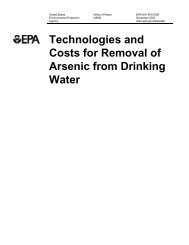Government of the People's Republic of Bangladesh Ministry of ...
Government of the People's Republic of Bangladesh Ministry of ...
Government of the People's Republic of Bangladesh Ministry of ...
You also want an ePaper? Increase the reach of your titles
YUMPU automatically turns print PDFs into web optimized ePapers that Google loves.
INTRODUCTION<br />
Geological Setting <strong>of</strong> <strong>the</strong><br />
Areas <strong>of</strong> Arsenic Safe Aquifers<br />
All water below <strong>the</strong> earth surface may be called subsurface or underground or ground water. A<br />
hole penetrating <strong>the</strong> ground, initially passes through <strong>the</strong> zone <strong>of</strong> aeration (unsaturated zone), in<br />
which inter granular spaces are normally filled mainly with air. The hole <strong>the</strong>n enters <strong>the</strong><br />
saturated zone in which all inter granular spaces are filled with water. The upper surface <strong>of</strong> <strong>the</strong><br />
saturated zone is called <strong>the</strong> water table and at any place it normally slopes toward <strong>the</strong> nearest<br />
stream. Very considerable amount <strong>of</strong> water occurs in more or less definite layers or rock<br />
formations that <strong>of</strong>ten extend at various angles for hundreds or thousands <strong>of</strong> meters into <strong>the</strong><br />
earth. Such water bearing layers or rock formations are known as aquifers. An aquifer is<br />
usually bounded above and below by materials impervious to water.<br />
In <strong>Bangladesh</strong> <strong>the</strong> most important environmental issue at present is <strong>the</strong> arsenic contamination<br />
in <strong>the</strong> ground water <strong>of</strong> <strong>the</strong> Holocene 1 aquifers <strong>of</strong> <strong>the</strong> Recent Alluvial deposits. The present<br />
paper deals with <strong>the</strong> aquifers <strong>of</strong> arsenic safe geological regions and superimposes <strong>the</strong>m on <strong>the</strong><br />
Upzila Map <strong>of</strong> <strong>Bangladesh</strong>. Lists <strong>of</strong> <strong>the</strong> Upzilas totally or partially belonging to this region are<br />
enclosed as Annex - 2 to Annex - 6.<br />
.<br />
GEOMORPHOLOGY OF BANGLADESH<br />
Topographically, <strong>Bangladesh</strong> is a plain land except <strong>the</strong> hills regions <strong>of</strong> east and nor<strong>the</strong>ast. The<br />
plain land mainly consists <strong>of</strong> fluvio-deltaic sediments deposited by <strong>the</strong> Ganges, <strong>the</strong><br />
Brahmaputra and <strong>the</strong> Meghna river systems.<br />
Geomorphologically, <strong>Bangladesh</strong> can be divided into four distinct regions each having<br />
distinguishing characters <strong>of</strong> its own.<br />
1. The Holocene Floodplains <strong>of</strong> <strong>the</strong> Ganges, <strong>the</strong> Brahmaputra and <strong>the</strong> Meghna river systems.<br />
2. The Bengal Delta<br />
3. The Eastern and Nor<strong>the</strong>astern Tertiary Hills Regions<br />
4. The Pleistocene 2 Terrace or <strong>the</strong> Pleistocene Uplands<br />
1. An epoch <strong>of</strong> <strong>the</strong> Geological Time Scale, approximately 10,000 years ago, to <strong>the</strong> present time; also, <strong>the</strong><br />
corresponding series <strong>of</strong> rocks and sediments deposits.<br />
2. An Epoch in <strong>the</strong> Geological Time Scale that started about 1.8 million years ago and lasted until <strong>the</strong> start <strong>of</strong> <strong>the</strong><br />
Holocene some 10,000 years ago, also, <strong>the</strong> corresponding series <strong>of</strong> rocks and sediments deposits.<br />
PDF created with FinePrint pdfFactory trial version http://www.fineprint.com<br />
A-4

















